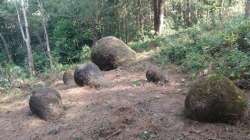Tall, mysterious ancient jars found buried in mountainous jungles of Assam
The researchers worked with local communities to uncover potential jar sites, often through areas of mountainous jungle that were difficult to navigate.

Researchers have unearthed 65 giant "mysterious" jars in Assam that may have been used for ancient burial practices. The sandstone jars uncovered by a team led by Tilok Thakuria, from North Eastern Hill University in Meghalaya, and Uttam Bathari, from Gauhati University in Assam vary in shape and decoration. Some of the jars are tall and cylindrical, while others are partly or fully buried in the ground, according to the study published in the Journal of Asian Archaeology. Similar jars, some of which span up to three metres high and two metres wide, have previously been uncovered in Laos and Indonesia, researchers said.
"We still don't know who made the giant jars or where they lived. It's all a bit of a mystery," said Nicholas Skopal, a PhD student at The Australian National University (ANU). The researchers said what the giant jars were used for is still a mystery, adding that it is likely they were associated with mortuary practices. "There are stories from the Naga people, the current ethnic groups in north-east India, of finding the Assam jars filled with cremated remains, beads and other material artefacts," said Skopal, who was a part of the research team.
This theory, the researchers said, aligns with the findings from the other jar sites in countries including Laos, which are also tied to burial rituals. The researchers said they only searched a very limited area so there are likely to be a lot more out there. "It seems as though there aren't any living ethnic groups in India associated with the jars, which means there is an importance to maintain the cultural heritage," Skopal said. "The longer we take to find them, the greater chance that they will be destroyed, as more crops are planted in these areas and the forests are cut down," he said.
The researchers worked with local communities to uncover potential jar sites, often through areas of mountainous jungle that were difficult to navigate. "Once the sites have been recorded, it becomes easier for the government to work with the local communities to protect and maintain them so they are not being destroyed," Skopal added.
Also Read | Assam CM Himanta Biswa Sarma calls for fresh NRC